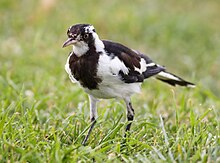Magpie-lark
| Magpie-lark | |
|---|---|
 |
|
| Female | |
 |
|
| Male | |
| Scientific classification | |
| Kingdom: | Animalia |
| Phylum: | Chordata |
| Class: | Aves |
| Order: | Passeriformes |
| Family: | Monarchidae |
| Genus: | Grallina |
| Species: | G. cyanoleuca |
| Binomial name | |
|
Grallina cyanoleuca (Latham, 1801) |
|
 |
|
| Distribution shown in green | |
| Synonyms | |
|
|
The magpie-lark (Grallina cyanoleuca), also known as the peewee, peewit or mudlark, is a passerine bird native to Australia and southern New Guinea. The male and female both have black and white plumage, though with different patterns. John Latham described the species in 1801. Long thought to be a member of the mudnest builder family Corcoracidae, it has been reclassified in the family Monarchidae (the monarch flycatchers). Two subspecies are recognized.
The magpie-lark was originally described by the English ornithologist John Latham in the genus Corvus in 1801 (as Corvus cyanoleucus). Its species name is derived from the Ancient Greek words cyanos "dark blue" and leukos "white" despite the black and white plumage. However, there can be a bluish sheen to the black back. In the same publication, Latham described the same species as Gracula picata. In 1843, Hugh Edwin Strickland proposed using the second name as it was the more accurate, resulting in Grallina picata. Formerly, some authorities have classified the magpie-lark as belonging to a genus of bee-eaters, Merops.
Latham gave the species the common names of blue and white crow and pied grackle, based on the scientific names.John Gould likewise called it the pied grallina in 1848, though he noted that it was called magpie-lark by the early settlers. Alternate names for the magpie-lark include the mudlark (more common in southeastern Australia) or pugwall (pug "clay"), from its nest, and peewee (more common in northeastern Australia), peewit, from its call. Unlike many species in southwestern Australia, the red wattlebird was given names by the local indigenous people that were onomatopoeic (sounding like the calls they make). Names recorded include byoolkolyedi (Perth and lowlands), dilabot (mountains and interior), and koolyibarak. Indigenous people in the Sydney region called it birrarik or birrerik.
...
Wikipedia

